If you can't read English, don't despair. In the same USA, almost 14% of the population, that is, 32 million people, cannot read! Moreover, 21% of the population reads at a fifth-grade level. But it’s never too late to learn to read English! Read this article and you will understand what you need to pay attention to.
Steps
Sharpening the Basics
- Sing. It will sound stupid, but songs are what help many people. The melody allows you to remember letters with minimal effort, shows the entire alphabet and the connection between letters.
- You can listen to the song online or by downloading it to your player.
- Feel it. If you're more hands-on, make letters out of sandpaper, then look at them, then close your eyes and use your fingers to trace the letter. After this, name the letter and the sound it denotes. Then remove your finger from the paper and use it to draw a letter in the air.
- Move. Take magnets in the shape of letters of the alphabet and move and move them, eventually forming words from them.
- Go ahead. If in a room, then take a floor covering with the letters of the English alphabet. Say the letter - step on the corresponding square. Ask someone to tell you the letters and step on the corresponding squares yourself. Let your whole body participate in the process of learning the alphabet!
-
Distinguish between vowels and consonants. Vowels English language are indicated by the letters a, e, o, u and i, the remaining letters represent consonants.
- Vowels seem to open your mouth when pronounced, while consonants, on the contrary, close. Vowels are pronounced without unnecessary sounds, but consonants are pronounced together with other sounds.
-
Use the phonics method to teach reading. With this method, you can better understand the relationship between letters and sounds. For example, when you learn when the letter “S” sounds like “sa” and when it sounds like “ka,” or when you notice that the syllable “-tion” is pronounced like “shun,” you are using the phonetic method.
- Choose one of the two classic methods that is convenient for you. The first one is the so-called “See-tell” when you learn to read whole words, or the so-called. “syllabic approach”, in which you first learn to pronounce individual syllables and their combinations, and only then words.
- The phonetic method is phonetic because it requires listening to the sound of syllables and words. To do this, you'll need an online program, a DVD, or someone willing to help you learn the pronunciation of different sound combinations.
-
Learn punctuation marks. It is very important to know what all the little squiggles and dots mean, because they carry a lot of important information for the correct understanding of the sentence.
“Attack” the words. This kind of tactic will help you learn the meaning and features of pronunciation unknown word, taking it apart and analyzing it sequentially.
- Look for visual cues. Check if there are photos, illustrations or anything like that on the page. Look at what is depicted there and how it may intersect with the meaning of the sentence.
- Voice the word. Say the word slowly and clearly. Then repeat the sounds themselves that make up the word, separately and clearly, starting from the very first.
- Split the word. Look at a word and see if it has any sounds, prefixes, suffixes, endings, or stems that you already know. Read each piece, then try to make a whole word out of them and read it.
- For example, you already know that the prefix “pre” means “before, in advance, before”, and the stem “view” means to look. What does the word “preview” mean? If you break it down into parts you know, you can even guess the meaning - this is a “preview”.
- Look for connections. Think about whether the words you don't know are similar to those you already know. Think, maybe this is a form of an unknown word, or part of something?
- Alternatively, try using a word you know in a sentence and see if the meaning is lost. It may turn out that the meanings of two words are close enough to each other to understand the connection between them.
-
Re-read. Have you read the proposal? Let's do it again. Replace words you don’t know with those you know, and analyze whether the meaning appears in the sentence.
Use your background knowledge. Consider what you already know about the topic of the book, paragraph, or sentence, and use that knowledge to figure out what the word is.
Make guesses. Look at the pictures, table of contents, chapter headings, maps, diagrams, and other parts of the book. Then, based on what you saw, write what you think about the book as a whole, what it might say, etc. Then start reading and see if your guesses are confirmed.
Ask questions. After reading the book's title, headings, looking at the images, etc., write down any questions you have about it all. Try to answer these questions yourself while you read the book, and write down your answers. If some questions remain unanswered, well, you’ll have to look for those who can answer them!
Visualize. Imagine that you are not reading a book, but watching a movie. Carefully, in every detail, imagine the main characters, the setting, and try to imagine how the story will unfold in space-time. It would be a good idea to make sketches of all this.
Build connections. Think about whether you can draw parallels with what you read from your own own experience? Maybe some of the characters in the book remind you of someone you know? Or have you encountered similar situations? Or maybe the book reminds you of a movie? Write down all the connections and intersections that come to your mind - with their help it will be easier to understand the book.
Start with the alphabet. The alphabet is the beginning of everything, and you will find 26 of its letters in all words. You can learn the alphabet in different ways, choose the one you like.
I often hear the following questions from parents: How do they teach children to read in English classes at school? Are there any techniques? What to do to teach your child to READ English?
In the educational complex “Spotlight”, which my daughter studies, already on page 20 the task is given: “Listen to the dialogue and read it.” Meanwhile, before this, in a few lessons they had only gone through the alphabet, got acquainted with greetings in English, learned the letter combinations sh, ch, th, ph (and no transcription was given) and ... that’s it. How is a child supposed to guess that friend is read frend and not friend? Who explained this to him? Next come numerous songs with a bunch of unfamiliar words that also need to be read. As homework. How are students supposed to learn how to read words like there (there, of course!), where (uhere:))... Naturally, everyone reads want as vant, welcome as welsome, etc. It’s a nightmare for my philological ears...Parents, quite naturally, run to their familiar “English girls”, and the end result is that all these theres are written down on a piece of paper with the correct transcription and the child is forced to memorize them. The child has a complete mess in his head: what’s wrong with this English, why do they scold me, I tried, didn’t I?
The fact is that there are many exceptions in English. Recently, English linguists discovered that the English language is the most difficult from European languages. At least it is the most difficult language to learn to read. Children of other nations master literacy in an average of year, and for this little Englishmen need two and a half years. So what do you want from your child?
For us Russian speakers, it is very difficult to understand that our can be read as [aue], their like [vea]. Some of my friends even in the 5th grade (and there are some in the 9th grade too, to be honest) read playing as [playing], and this is sad... Meanwhile, graduates of one private kindergarten I know calmly read in English and write in block letters.
I think you understand that giving your child explanations about closed and open syllables at this stage is useless. No need to say:
This is the letter “si”, read “s” before the vowels e, y, i; before the vowels a, o, u – reads like “k”... Got it? – Yes! And this is the letter “e”. In the closed position it reads... etc.
There is one rule in the English method: before starting to read, the child must listen a lot. And then we learn to read the words we have heard many times (from different songs, poems, etc.). Gradually. For example, let’s take Vereshchagina’s textbook for 2nd grade, which has already become a classic. Until the 18th lesson, no one asks children to read anything. Typical tasks up to the 18th lesson: “listen carefully..., learn to pronounce, act out a dialogue, etc.” Up to this point, all letters and their corresponding sounds are introduced sequentially.

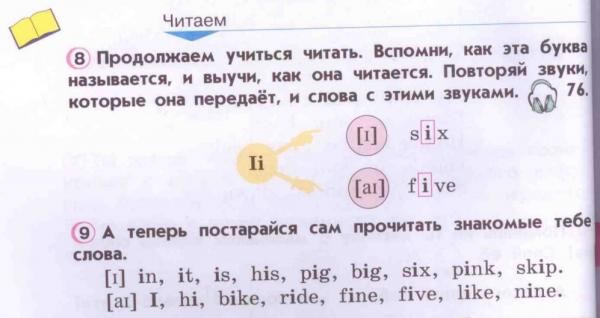
Please note: over the course of a series of lessons we consistently reinforce the reading of the letter Ii. Sounds and are given.
But this task is already aimed at establishing correct English intonation.

And then we continue to work in the same spirit. In the textbook “Starlight” for 2nd grade, work is also carried out in a similar way. Therefore, children at a calm pace, gradually and consistently learn to read words they already know by ear. One problem is that the textbooks “Starlight”, like “English” by Vereshchagina, are designed for in-depth study; they are written for special schools in which 3-4 hours a week are allocated to English.
What should the rest of the children do?..
When I'm trying to solve this problem for second graders in a regular school, flashcards help me a lot. The fact is that children often have a photographic memory and read words entirely, without any rules. This is very important point: For many children, it is completely insufficient to see words only in a textbook. It is necessary to “take” them outside the textbook and (of course!) PLAY with them. Therefore, I am not lazy to search the Internet for cards on the topics covered, plus make them myself, then print and cut them out, and then play them with the children in my classes. For example, it might look like this.
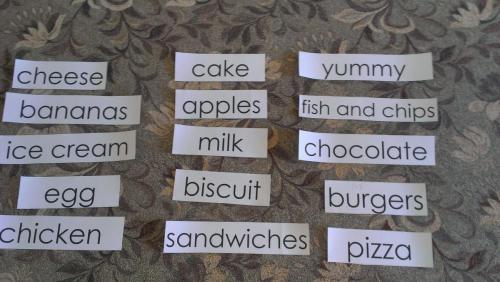
![]()
Why aren't they on the table? It’s just boring for children to sit for the entire lesson, all 40 minutes, at the table and point their finger at the textbook. That's why we leave the table and play. The tasks can be very diverse: choose from a variety of cards all the words on the topic “Food”, choose words with the letter combination sh or ch, who can find five words with any sound faster... Children run around with these cards until there is a whistle in their ears costs. Interesting, dynamic, effective. You can read more about such games in one of the following blogs about elementary school.
And this is also a wonderful prevention of scoliosis, physical inactivity, myopia and other troubles that are talked about so much at school meetings (and at parent meetings, For example. You can’t talk about money for an hour, you can talk about health sometimes). That is, this is how I connect “health-saving technologies” - it sounds scientific, but in fact everything is simple.
Conclusion: if you want to help your child learn to read in English, first understand that this is a long process that requires slowness and consistency. And patience will also come in handy. Some students started reading Russian only recently. Therefore, arm yourself with patience, print out the cards and read them. Every day. Doesn't work? We write the necessary sounds on top. Preferably in English, in transcription. Don't understand? Then in Russian! Now let's play with cards. Every day. We voice these words many times. 10-15 minutes, no longer. As a result of such training, your child remembers words as pictures and begins to read them correctly. Now we print out the next portion, and again we go according to the algorithm. Yes, by the way, what should those parents do who themselves cannot read English, for example, they studied German at school? I wrote about this here.
There is an opinion that teaching reading in English only according to the principle “remember the word as a picture” is harmful; it is necessary to explain the rules of reading. My practice shows that this is not so. You explain the rule, then the word have appears (according to the rule you need to read), and that’s it - bewilderment is guaranteed for half a lesson. Naturally, a little later the child’s brain begins to deduce patterns on its own, this really happens, I observe it. And again, a little later we will reinforce these patterns with explanations about closed/open syllables. He will work on Rusinova’s simulator, for example. But not now, not at the very beginning.
Remember that this process of learning to read can be slow. Help your child, support him. Don't blame yourself for mistakes.
Have you learned to read? Constantly reinforce this skill. Read simple texts. Then it gets more complicated. Read every day. From a textbook, from other sources. With such daily training, the child simply gets used to English words. We apply other recommendations, and over time, your child gradually gets used to spoken and written English speech and begins to develop a linguistic understanding. The more practice, the faster it will appear, the easier it will be to continue speaking and reading in English.

You will see everything for yourself. Everything is spelled out there too, as you may have guessed, and the exercises are the most useful. And most importantly, you don’t need to ask your children to go there and study, as practice shows, they themselves kick their mother out from behind the computer to play, look at colorful pictures (and at the same time learn to read + learn new words, without even realizing it).
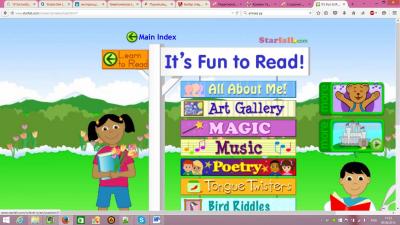
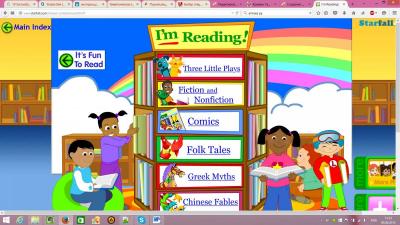 Next levels - sections It'sfuntoread(It's fun to read) and I'mreading(I'm reading).
Next levels - sections It'sfuntoread(It's fun to read) and I'mreading(I'm reading).
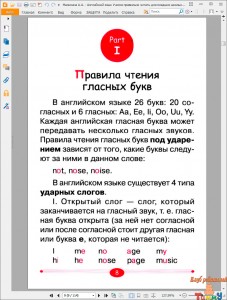
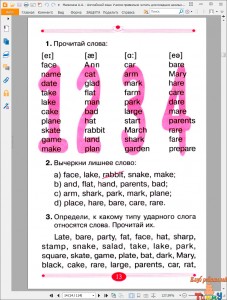

Book summary:
The book will help systematize and consolidate the rules for reading vowels, consonants and letter combinations. The manual can serve as a supplement to any textbook for primary classes and can be used both in lessons and for independent work Houses.
The book gives rules for reading vowels, consonants and letter combinations. You can work through the rules sequentially, or you can use this book as a reference guide as difficulties arise when studying a particular rule.
A young child has well-developed long-term memory. Everything he taught is remembered for a long time. Therefore, you should take advantage of children's memory to remember reading rules. In order for the child to quickly cope with unusual rules, words are offered, most of which correspond to the age of the students, as well as entertaining tongue twisters and funny poems, some of which are recommended to be learned by heart.
Color signaling is used to reinforce reading rules.
Download the book “English: Learning to read correctly: for primary schoolchildren” for free in PDF format:
Download the book “English: Learning to read correctly: for primary schoolchildren” for free in DJVU format:
You can find others in the section of our parents club of the same name.
All books are stored on our Yandex.Disk and there is no charge for downloading them, as well as viruses and other nasty things.
Publications on the topic:
Annotation for the book: The manual is intended for teaching reading to children beginning to learn English. It can be used by secondary school students...
Book summary: The book is a unique guide to the basic rules of reading and pronunciation in English. With her help...
Abstract to the book / collection of exercises: The collection is a selection of game-oriented lexical exercises on the following topics: ABC, “Parts of the body,...
Abstract to the book - textbook: The publication provides in a condensed, concentrated form the main theoretical material covering the elementary English language course...
Book summary: The book presents all the basic rules of the English language studied in elementary school. Pronunciation information provided...
Summary of the book - textbook: It is best to develop reading skills using accessible and interesting material. Entertaining stories, fairy tales, poems...
Book summary: The book is a reference book on English grammar. This is one of the few publications in which grammatical material is presented...
Abstract to the book - textbook: The publication provides in a condensed, concentrated form the main theoretical material covering the elementary Russian language course...